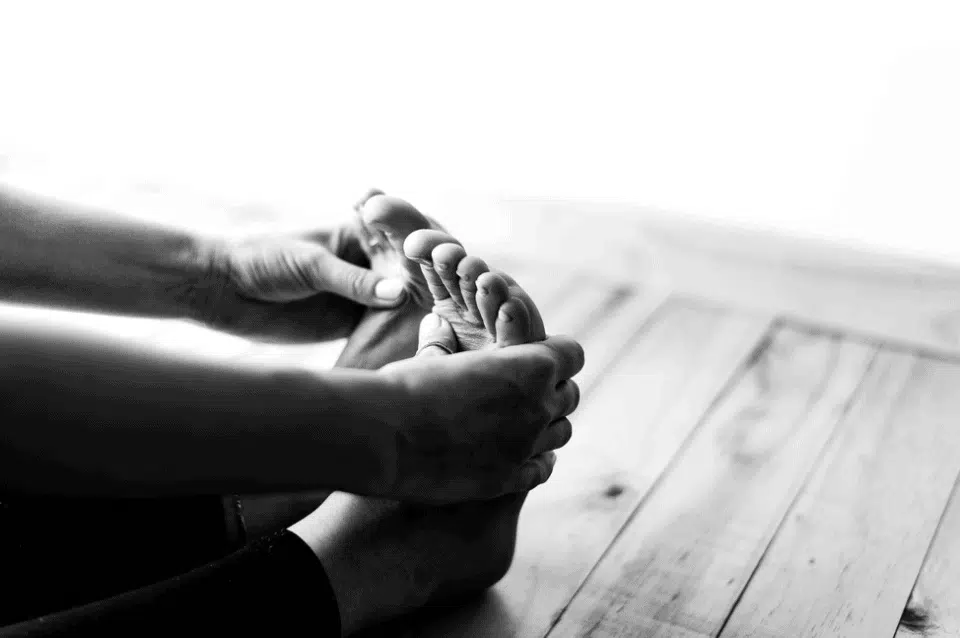Taking proper care of your feet is an essential part of life; your feet allow you to walk, run, and stay active.
However, these simple tasks can become a burden if you suffer from plantar fasciitis.
For those that are wondering, “what is plantar fasciitis?”, it’s a common foot condition that causes your plantar fascia (the connective tissue that runs between your toes and heel) to become inflamed and irritated. This results in severe heel pain.
Our team at Feet First Clinic knows how painful plantar fasciitis can be; that’s why we want to help you deal with and recover from your condition.
For those that aren’t familiar with us, we’re a team of foot care experts in downtown Toronto that specialize in orthopedic services and assessments. Our team also offers a wide range of foot-related products, like:
- Custom-made orthotic insoles
- Compression stockings
- Custom-made shoes
Continue reading to learn more about how you can relieve pain caused by plantar fasciitis.
Who Needs to Worry About Plantar Fasciitis?
Before delving into the topic, it’s always a good idea to take the time to learn if you’re at risk of developing plantar fasciitis.
Anyone can potentially develop this condition; there have been reported occurrences in several age groups, ranging from young children to the elderly.
However, plantar fasciitis appears to be more common in women who are pregnant or overweight. This is because the muscles in your feet have to support more weight than they are used to.
However, women that lead an active lifestyle are also at risk of developing this condition, especially if they participate in repetitive physical sports, like running. These sports can agitate your plantar fascia and increase the chances of developing this condition.
Additionally, the risk of developing plantar fasciitis is even higher for women between the ages of 40 and 70.
Tips for Dealing with Pain
Do you currently suffer from plantar fasciitis? Then you should make use of the following tips and tricks the next time it flares up:
1. Sit Down and Rest
This is the first thing that you should do after experiencing plantar fasciitis-induced pain. Sitting down takes the pressure off of your plantar fascia (and the rest of your foot), which can help relieve the pain.
While sitting down, you should try to keep your foot elevated. This will help increase blood flow and reduce the swelling. You can also give yourself a foot massage for additional pain relief. However, don’t be too rough, as your foot muscles will feel tender and sore.
2. Purchase a Pair of Custom Orthotic Insoles
You’re most likely familiar with custom orthotics; these unique insoles are relied on by people around the world.
This is because orthotic insoles can:
- Help reduce overall impact while walking, running or playing sports
- Minimize leg, back and neck pain
- Reduce pain caused by foot deformities (bunions, hammertoes, etc.)
Orthotics are also extremely beneficial for people that suffer from plantar fasciitis. This is because they can improve the wearer’s pronation control.
For those that don’t know, pronation of the foot is when the arch lowers on the inner, medial margins. Having poor pronation control can lead to excessive foot fatigue and contribute to your plantar fasciitis.
The best insoles for plantar fasciitis also offer several long-term benefits. Wearing orthotics can prevent foot conditions, like plantar fasciitis, from getting worse. This is because they can help reduce muscle imbalances in the feet and lower body.
If you’re thinking about purchasing a pair of orthotics for plantar fasciitis, you should avoid going with an over-the-counter product; instead, you should consider opting for our high-quality, custom orthotics for plantar fasciitis.
Our custom-crafted orthotic insoles for plantar fasciitis can help you increase your pronation control while relieving stress in your arches and heels. Not to mention, we can customize your insoles to fit in any shoe. This means that you’ll never have to go a day without them!
Custom orthotics aren’t just beneficial for people who suffer from plantar fasciitis; they can also help people who have the following conditions:
- Flat feet
- High arches
- Diabetes
3. Take Action and Be Prepared
Your plantar fasciitis can flare up at any moment; it could strike while you’re working, at school, or doing chores around your home.
However, you can’t let your plantar fasciitis take control of your life — you need to take action!
There are several small things that you can do to make your foot pain more manageable. Two practical examples include icing your foot and taking pain medication.
Icing your foot is a quick and easy way to relieve plantar fasciitis-induced pain and relieve swelling. If you’ve experienced a flare-up while working, you may want to keep an ice pack in your lunch box or the freezer at work (if there’s one to use). This will give you quick access to ready-to-use ice.
Over-the-counter pain mediation can also help you deal with your foot pain. Store-bought pain medication contains additives that stop your cells from producing prostaglandin (a chemical that is naturally produced within our bodies). When this happens, our nerve endings feel less sensitive; thus, we feel less pain.
Although these medications don’t provide permanent relief, they do make the pain much more manageable for a short period. To be safe, you should keep a small amount of over-the-counter medication in an accessible area, like your vehicle or office.
Pain-Relieving Exercises
Although they are helpful, you can’t rely solely on ice and pain medication. If you want your plantar fascia to heal correctly, you should start doing exercises that can prevent your foot condition from getting worse.
At Feet First Clinic, our team is happy to demonstrate several useful (and easy) exercises. However, if you don’t have time to book an appointment with one of our specialists, you can use the following exercises to prevent plantar fasciitis from getting worse in the meantime:
1. Towel Stretch
One of the first exercises that you’ll want to familiarize yourself with is the towel stretch. This simple exercise helps strengthen the muscles in your feet without straining the rest of your body.
Here are some step-by-step instructions on how to complete a towel stretch exercise:
- Sit down on a hard surface (preferably carpet) with your legs forward and knees straight
- Wrap a towel around the upper portion of your foot and toes
- Hold the towel with your hands and apply pressure by pulling back
- Hold for 15 to 30 seconds (don’t force yourself to exceed this)
- Repeat the exercise four more times
For the best results, you should repeat the entire process at least five times a day.
2. Calf Stretch
The calf stretch is another simple exercise that requires a minimal amount of equipment. Calf stretches help relieve built-up tension in your feet and heels.
Here are some step-by-step instructions on how to complete a calf stretch exercise:
- Find a sturdy wall and place your hands on it (at approximately eye-level)
- While your hands are on the wall, take one step back with the compromised foot
- Stretch your front leg inwards while bending your other knee (remember to keep your back heel on the floor during this step)
- Hold this position for 15 to 30 seconds
- Repeat the exercise two to four times per day
Doing this will loosen up the muscles in your lower body and help relieve a substantial amount of pain.
3. Tennis Ball Roll
There are several unexpected uses for tennis balls. But, did you know that rolling a tennis ball under your affected foot can reduce pain and speed up the healing process?
As you roll the ball under your foot, you’re applying pressure to the plantar fascia. This massages the tissues and muscles in the bottom of your foot.
Here are some step-by-step instructions on how to complete the tennis ball roll:
- Place a tennis ball on a hard surface (preferably carpet)
- Without applying too much pressure, step on the tennis ball (if you have poor balance, you can use a chair or table for support)
- Roll the tennis ball around the affected area for 15 to 30 seconds at a time
- Repeat this motion two to four times, then repeat the entire process twice more throughout the day
Bonus Tip – If you don’t have a tennis ball handy, you can use a frozen water bottle!
4. Marble Pick Up
To finish up the workout session, you should try a marble pick up exercise. This exercise works the muscles in your toes and upper portion of your feet.
Here are some step-by-step instructions on how to complete the marble pick up:
- Place a small pile of marbles on a hard surface
- While sitting on a chair, pick up the marbles with your affected toes
- Repeat the process two to four times per day
It’s worth noting that this is one of the more challenging exercises on the list and should be during the latter stages of the healing process.
If you’ve recently developed or suspect that you’re developing plantar fasciitis, you should make use of the tips and exercises listed above. If you’re still struggling with your condition, one of our team members will be happy to help you come up with a recovery plan.










